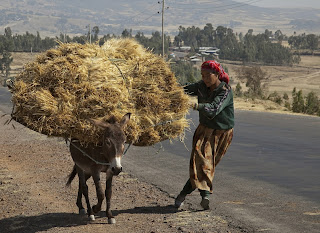 |
| (c) Demidoff. Dreamstime.com |
supplied power for farm work, and provided transport, proving particularly useful in semi-arid and otherwise inaccessible areas.
They constructed a comprehensive genome panel containing 207 modern and 31 ancient donkeys, as well as 15 wild equids.
Reporting their findings in the journal Science, the researchers reveal that the donkey was first domesticated in Africa in 7,000 years ago, around the time when the Sahara became the desert region we know today.
They state that it was only 2,500 years later that donkeys left their place of origin in Africa and reached Europe and Asia, where this species developed lineages that, in some cases, still exist today.
“We found a strong phylogeographic structure in modern donkeys that supports a single domestication in Africa ~5000 BCE, followed by further expansions in this continent and Eurasia and ultimately returning to Africa.”
By analysing archaeological remains, scientists also uncovered evidence of a previously unknown genetic lineage of donkeys that lived in the Levant, around the eastern Mediterranean, 2,000 years ago. The influence of this lineage is thought to extend far beyond the region, and still today, fragments of its genetic heritage can be found throughout Europe.
The researchers suggest that these discoveries call for new archaeological digs to find the initial source of domestication in Africa, as well as the sequencing of other early donkey genomes on both shores of the Mediterranean sea, to better understand the role of this animal in the history of trade between Europe and North Africa.
For more details, see:
The genomic history and global expansion of domestic donkeys.
Evelyn T. Todd, Laure Tonasso-Calvière, Lorelei Chauvey, Stéphanie Schiavinato, Antoine Fages, Andaine Seguin-Orlando, Pierre Clavel, Naveed Khan, Lucía Perez Pardal, Laura Patterson Rosa, Pablo Librado, Harald Ringbauer, Marta Verdugo, John Southon, Jean-Marc Aury, Aude Perdereau, Emmanuelle Vila, Matilde Marzullo, Ornella Prato, Umberto Tecchiati, Giovanna Bagnasco Gianni, Antonio Tagliacozzo, Vincenzo Tinè, Francesca Alhaique, João Luís Cardoso, Maria João Valente, Miguel Telles Antunes, Laurent Frantz, Beth Shapiro, Daniel G. Bradley, Nicolas Boulbes, Armelle Gardeisen, Liora Kolska Horwitz, Aliye Öztan, Benjamin S. Arbuckle, Vedat Onar, Benoît Clavel, Sébastien Lepetz, Ali Akbar Vahdati, Hossein Davoudi, Azadeh Mohaseb, Marjan Mashkour, Olivier Bouchez, Cécile Donnadieu, Patrick Wincker, Samantha A. Brooks, Albano Beja-Pereira, Dong-Dong Wu, Ludovic Orlando.
Science, (2022). Vol 377, Issue 6611 pp. 1172-1180

No comments:
Post a Comment